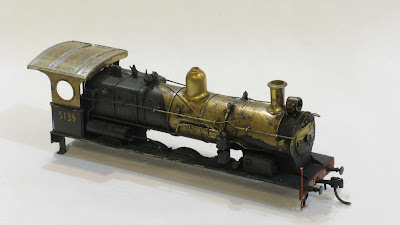Of course you have to take it home and try it out right away but I had visitors, I got to it later that night. Some years ago I inherited some model trains from Chris' uncle and among it there was an original run Model Dockyard C38 that had been stripped of paint and a few brass parts as well after it had been left in the stripper for a number of days. It had remained in this state since then and was very tarnished.
I set up a plastic storage box as a temporary sand blasting cabinet and had a try. Now I thought that some of you would be interested and have a use for one of these so I set up my video camera of the sand blaster in action.
Unfortunately the sand blasting grit is 220 microns (0.22mm) grain size and after I was finished the video I found that the grit had flown out of the box and was everywhere for a half a metre or so. This led me to buy another storage box that had a lid that was reasonably see through and I cut a couple of hand/arm holes into it. I thought about fitting gloves like the real cabinets but figured that not much grit would escape when my arms virtually fill the holes. I also fitted a grommet into the side of the box to allow the hose to come into the box, attaching the sand blaster inside the box. A small bracket is supplied to hang the blaster on so I screwed this to the wall of the box also.
Here are a couple of photos of the 'cabinet'.
The blaster comes with a small container of the grit and I didn't see any other supply at Super Cheap Auto (I will watch for it). I would suggest that you save the used grit for re-use as I am sure that the small amount of brass, etc. wouldn't be a problem. I should mention that the nozzle has a ceramic insert.
I am interested to try this blaster on scenic elements such as ageing wood structures/parts, 'weathering' wagons and perhaps ageing signs on the side of model buildings to name a couple.
If you buy one and come up with some other uses let me know.










